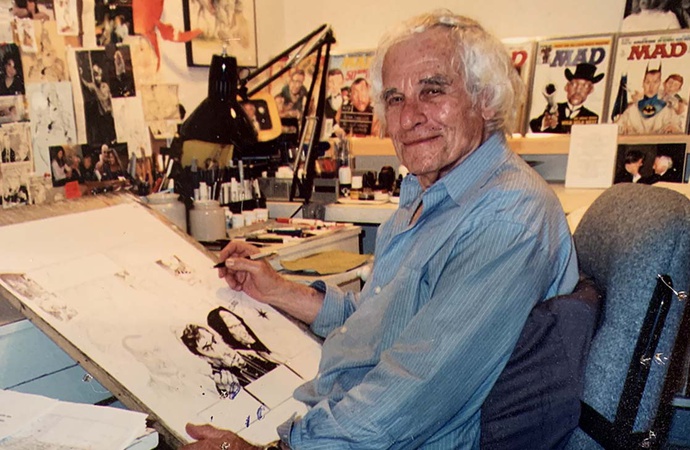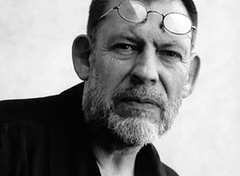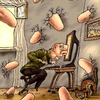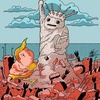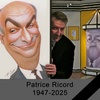Mad Magazine illustrator Mort Drucker dies at 91
Mort Drucker, the Mad Magazine cartoonist who for decades lovingly spoofed politicians, celebrities and popular culture, died Thursday 8/4/2020 at 91.
Morris "Mort" Drucker(March 22, 1929 – April 9, 2020)was an American caricaturist and comics artist best known as a contributor for over five decades in Mad, where he specialized in satires on the leading feature films and television series.
Personal life
Drucker was born in Brooklyn, New York City,with some sources listing his birth date as March 22, 1929, and others as March 29
He was the son of Sarah (Spielvogel), a homemaker, and Edward Drucker, a businessman.
His family was Jewish.He attended Brooklyn's Erasmus Hall High School. There he met his future wife Barbara, whom he married shortly after her graduation. The couple moved to Long Island, living in Syosset, where they brought up two daughters, Laurie and Melanie; their family eventually expanded with three grandchildren.
His daughter Laurie reported that Drucker died on April 9, 2020, in his Woodbury, New York home.
Career
Drucker entered the comics field by assisting Bert Whitman on the Publishers-Hall newspaper comic strip Debbie Dean in 1947 when he was 18, based on a recommendation from Will Eisner. He then joined the staff of National Periodical Publications (DC Comics), where he worked as a retoucher. While at DC, Drucker also ghosted "The Mountain Boys", Paul Webb's regular gag panel for Esquire Magazine.Early in the 1950s, Drucker left his DC staff gig and began doing full-time freelance work for a number of comic book publishers such as Dell, Atlas and St. John's, as well as several humor and war titles for his former employer.

Mad
In the fall of 1956, shortly after the departure of Mad's founding editor Harvey Kurtzman, Drucker found his way to Mad. His first visit to the magazine's offices coincided with a World Series broadcast, and publisher Bill Gaines told Drucker that if the Brooklyn Dodgers won the game, he would be given a drawing assignment. The Dodgers won. Capricious though Drucker's alleged audition process may have been, it was a good anecdote. Years later, Gaines unsurprisingly confessed, "We would have hired him anyway."
Drucker had arrived at the Mad offices with pages from his Hopalong Cassidy comic book work for DC Comics and some of his "Mountain Boys" strips, as well as a humorous "little situation" featuring The Lone Ranger and Tonto that he had specifically drawn for the interview. Though this work was unlike the likenesses and continuities he would become best known for, the Mad staff reacted favorably. The first to review Drucker's portfolio was Mad associate editor Nick Meglin, who admitted, "I didn't spot how great he was at caricatures. Not at first. But then, he wasn't that great then." Drucker himself says that he "just wanted to be an artist ... to get paid for drawing anything," and only started focusing on caricature work because he started getting more of those assignments. "That's when I realized I'd found my calling," said Drucker.At the time of Drucker's arrival, Mad did not regularly feature TV and movie satires. Editor Al Feldstein credited Drucker's style and ability for the decision to start featuring them in every issue.
For well over a decade, Mad had difficulty obtaining promotional photos that Drucker could use as source material for his drawings.When he was illustrating Mad parodies, Drucker's colleague Angelo Torres brought a camera into movie theaters and snapped pictures of the screen. Eventually, a generation of Mad fans grew up and some became Hollywood publicists, making Drucker's research easier.
By the time he wound down his Mad career 55 years later, Drucker held the longest uninterrupted tenure of any Mad artist. Drucker has the most bylined articles by any Mad artist who does not also write his own material, with more than 400.
Other work
Drucker also remained active for DC, illustrating War Stories, among other titles. Beginning in 1959, he spent four years drawing DC's The Adventures of Bob Hope comic book.[8] Drucker credits this stint as a key moment in his career because it focused his work on caricature.
In 1962, Drucker teamed with the prolific humor writer Paul Laikin on the highly successful JFK Coloring Book (Kanrom Publishers), which sold 2,500,000 copies. Two decades later, Drucker illustrated similar coloring books on Ollie North and Ronald Reagan. His film posters include Universal's American Graffiti (1973), directed by George Lucas with Drucker also drawing the high school yearbook pictures in the film trailer.
Drucker also pursued assignments in television animation, movie poster art and magazine illustration, including covers for Time, some of which are in the National Portrait Gallery of the Smithsonian Institution. His album covers include art for the pop band The Bears and the Anthrax album State of Euphoria, as well as hu

Mad magazine was a cultural institution for millions of baby boomers, and Drucker was an institution at Mad. A New York City native, he joined Mad in its early days, the mid-1950s, and remained well into the 21st century.
Few major events or public figures during that time escaped Drucker's satire, whether “Star Trek" and “The Godfather” or Steve Martin and Jerry Seinfeld.
In large strokes, Drucker took in every crease, crevice and bold feature.
The big jaws of Kirk Douglas and Jay Leno bulged even larger, while the ears of Barack Obama looked like wings about to take flight. Being drawn by Drucker became a kind of show business right of passage, with Michael J. Fox once telling Johnny Carson that he knew he had made it when he appeared in a Drucker cartoon.




